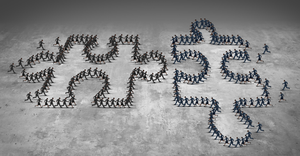Geospatial Technology Scores Big in Super Bowl 50 Waste Cleanup
In the run up to the Super Bowl 50, which concluded with the Denver Broncos victory over the Carolina Panthers, fans in the Bay Area were treated to days of concerts, celebrations and activities.
As a Super Bowl Super Community, San Jose played host to the Panthers for the week leading up to the Big Game. The team slept in a downtown hotel and practiced at San Jose State University field. Many Super Bowl-related family events were held in the venue city and the Super Bowl Opening Night Fueled by Gatorade was at San Jose’s SAP Center.
But long before it was decided which teams would battle it out for the championship, some serious housekeeping took place in San Jose.
Piles of discarded trash have been an issue in San Jose for years, according to the city, which reported a 75 percent increase in illegal dumping over the past several years. In fact, city council recently approved leveling fines against perpetrators, but the problem has continued.
According to California Department of Resources Recycling and Recovery (CalRecycle), illegal dumping of materials such as large appliances, furniture, waste tires, computers, and household refuse is a problem in many California communities. The waste poses significant social, environmental, and economic impacts statewide. California local governments spend tens of millions of dollars annually to remove illegally dumped materials, and private property owners incur significant costs to clean up dump sites. Those that are not abated often grow in size and become illegal disposal sites.
As San Jose was expecting a sea of visitors Super Bowl week, cleanup became a larger issue.
It seems the attention from the ensuing crowds was an impetus for the cleanup, says Rick Gosalvez, local government market manager for Trimble Geospatial Solutions. After all, the festivities including and surrounding the game could represent an $800 million opportunity to the Bay Area, he says.
“Certainly with the economics behind it, it was a driving decision behind it,” he says.
In the short term, says Gosalvez, it was about the Super Bowl, but in the long term, it was about the residents of San Jose.
“But the city of San Jose is starting to think very comprehensively about (illegal dumping).”
It was just three months ago, when funding was approved for cleanup of illegal dumping sites across San Jose. A previous pilot program aimed at reducing illegal dumping determined key hot spots that had become dumping grounds for everything from mattresses to televisions.
The city, in collaboration with SJSU, and CommUniverCity, chose Trimble’s geospatial technology to determine the best way to deal with various types of trash being dumped. The cleanup covered six areas broken into 3 days of work, mostly in the downtown area of the city. It consisted of 1,061 points of collection made up of approximately 60 percent trash, 30 percent shopping carts and 10 percent hazardous materials, says Gosalvez .
That data established a baseline, he says. Later this month, the assessments will be repeated to determine whether there has been any sort of reduction in dumping, what the patterns might be and how they might engage the community for solutions. The cleanup is ongoing.
The pictures and maps allow communities to have a conversation about what is going on, says Gosalvez says. The technology is easily accessed from mobile devices and computers both in the field and in the office, which improves efficiency, communication and data sharing.
It’s useful, says Gosalvez, because haulers aren’t contracted to pick up illegal dumps. The technology documents what type of waste is dumped so the contractor can take care of the waste properly, whether it is a hazardous material, electronics or another type of waste. Trimble’s technology tracks the types of waste and where the dump sites are located.
One item discovered over and over, for example, was shopping carts. According to Gosalvez, it was important to determine whether the carts were abandoned. If the cart had become the property of a homeless person, the city could not remove the cart. Other items, like mattresses, electronics and paint and oil cans also were found dumped in areas around San Jose.
About the Author
You May Also Like


.png?width=300&auto=webp&quality=80&disable=upscale)